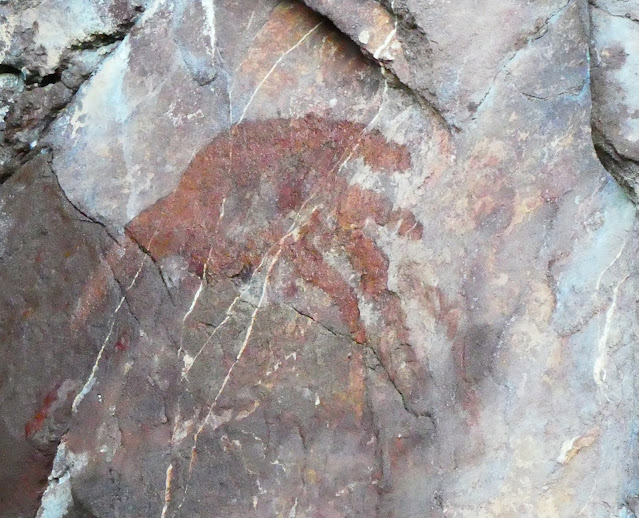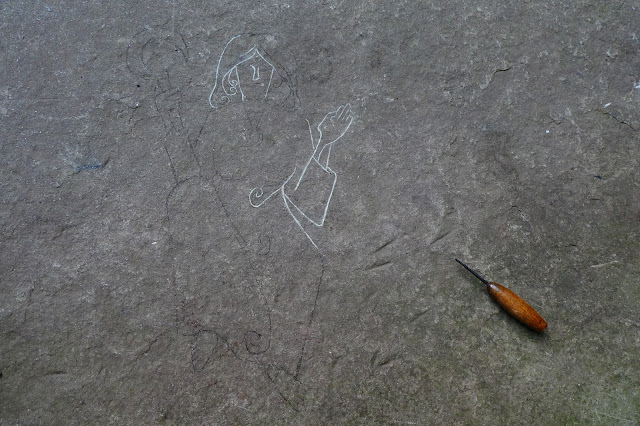Schrödinger's Rockcat: Quantum Ghosts, Derrida and Hauntology
In Chapter XLII and XLIII, Womba and her small band encounter a giant sea-snake on their voyage to the Ylflands in a Homer-esque encounter, a meeting of bold voyagers versus grisly denizens of the deep. With characteristic gusto, the Ulfish warrior Ffreow throws himself into the fight and Womba bravely backs him up - only to be overcome by the beast's lethal venomous breath. So ends Chapter XLII. As XLIII begins, Womba awakens on the shore, 3 days after the events with the sea snake, finding herself stretched out on sunny sand and friends gathered around her. "Who heals the healers?" asks Gifli, as Womba is herself a renowned healer, and it seems Gifli is too, having patched up a battered Gerthild as well. As Womba gets her head straight, her memories return: while out cold, she had a dream. Or perhaps something more:
"...her dreams of torment, twisted thoughts,
and scenes of terror filled her mind:
a broken path, of blood and bones,
and jagged upthrust rocks beneath
which shredded boots and flesh alike;
her endless journey downward went,
until she saw the river’s edge;
the everflowing stream of blood,
and stood across, with hands upraised,
great Smorian, the one who chokes,
the mother of Fyrfax, Gyldland’s bane.
They faced each other, queen and wife,
and silence, endless, passed between
while Womba stared, though frozen fast,
upon the threshold, judgement bound;
no sign of Ullek, hearth or fire,
greeted her: the wastelands waited.
Then, “Take this, please,” and back she was
in friendly, living company..."
Womba's liminal experience sees her standing at the threshold of the underworld, facing the queen of the dead across the river Forgyettan, from which are siphoned the memories of all souls who cross it - a final and irrevocable act, rendering the spirit-form unaware of its own self and past, and fettering it forever in the land of the dead. Womba returns to the land of the living, but for three days her existence is in the balance, somewhat coincidentally like the experimental cat of Schrödinger's 1935 paper, the only piece of quantum theory that almost everyone has heard of. Karen Barad refers to this paper in her essay "Quantum Entanglements and Hauntological Relations of Inheritance: Dis/continuities, SpaceTime Enfoldings, and Justice-to-Com" and what I thought at first was an amusing correspondence (my equally fictional not-dead but not-alive cat caught between the worlds of life and death) actually turned out to have some resonance. For it is in that literal gap in the text - between chapters LXII and LXIII - that Womba's fate is decided.
Barad's essay was recommended in a recent tutorial to help me get to grips somewhat with Derrida's deconstructionism and how it could be applied in a critical way to the work I'm creating here, given the excessive amount of text being produced in its realisation (including this very blog). Smorian herself may be seen as a kind of ghostly figure, as befits any queen of the dead: she is, after all, seen only by ghosts, those who have departed their physical forms (though not necessarily severed therefrom), and therefore to speak of her in a truly experiential sense (rather than merely about her, as in heresay) requires the speaker to be (or to have been) a ghost: for until such a meeting arises, the speaker can only speak speculatively of what cannot truly be spoken of: 'the impossibility of death in the mind of someone living', an ontological positioning for which their is no previously-held, empirical experience, no prior knowledge of what such a state of being or experience entails.
Barad quotes Derrida:
“If it– learning to live– remains to be done, it can happen only between life and death. Neither in life nor in death alone. What happens between the two, and between all the ‘two’s’ one likes, such as between life and death, can only maintain itself with some ghosts, can only talk with or about some ghost.
So it would be necessary to learn spirits. (Derrida 1994, xviii)”
and then returns to the cat:
"A cat caught in a superposition of alive and dead. An awkward affair. A ghostly/ghastly position. Its fate entangled with an atomic critter–a radioactive atom, a small bit of matter ruled by probabilities (forget about the impossibility of the metaphor). The famous Schrödinger’s cat experiment: a Rube Goldberg-style machine, coupling a radioactive atom to a Geiger counter to a hammer to a bottle of poison to the fate of the cat. What has driven Schrödinger to such perverse lengths? He’s trying to make a point about measurement and he understands that the kind of sympathy we muster for cats, we don’t seem to have for electrons or photons, or any of the critters that populate the world of the nonliving. A world perhaps more densely populated than on first thought, if one includes the undead, that is, all matter of spooks...What does it mean for the cat’s fate to be entangled with that of an atom? If the atom decays, the cat dies; if the atom doesn’t decay, the cat lives. But the atom’s fate is indeterminate, in ‘a superposition of having decayed and having not decayed’. Correspondingly, due to their entanglement, the cat is ‘in a superposition of alive and dead’! Our sympathy clicks in! Outrageous! What? How can this be? It’s one thing for an atom to be in a superposition of decayed and not decayed, but cats are either alive or dead – period. And Schrödinger would be the first to agree, but only after the state of the cat is observed.
Before it is observed, there is no determinate fact of the matter about its condition."
(Barad, Entanglements)
My reader is my observer, unsure of which world the poisoned-but-not-yet-actually-dead-(or-alive) (Rock)cat occupies. They may assume that because Womba is the hero, that she will not die (yet, here, at this juncture), but other characters before (and after) come back from the dead in ‘undead’ form, so that’s no guarantee. If we permit the mythical world of Womba et al to accommodate a Cartesian body/soul literal dichotomy, in which one can be divorced from the other, then Womba has indeed occupied the liminal space of ‘in-betweenness’ by virtue of her body remaining on the beach, and its vital signs sustained only because the spirit has not yet ‘crossed over’ and had its connecting thread severed by the queen of the dead.
Hence why I found myself viewing the character of the Rockcat in a very different light after digesting Barad’s opening quotes from Derrida:
“If I am getting ready to speak at length about ghosts, inheritance, and generations, generations of ghosts, which is to say about certain others who are not present, nor presently living, either to us, in us, or outside us, it is in the name of justice.... It is necessary to speak of the ghost, indeed to the ghost and with it.” —Derrida (1994, xix)
As in Hamlet, the Prince of a rotten State, everything begins by the apparition of a specter. —Derrida (1994, 4)"
Derrida, elsewhere, refers to the first noun mentioned in Marx’s Communist Manifesto as being ‘specter’, one which haunts Europe (now, as then, as fate would have it).
The epic poem does indeed open with “the apparition of a specter”:
“Listen here. We have heard that once
in former days, when wizards walked*
and wyrms still flew, the wrathful ones,
there was a Rockcat, in Gyldland's fens
named Womba the Wise, a well-bred maid;
daughter of Deor, who was son of Strynd,
heroes both of the Wars of Vjal...”
“Once...there was.” Was – but no longer is. She may be dead now, or never existed, but in either outcome she remains a ghost, a liminal figure, intangible, a being whose fate can only be decided by observing (the text, in this case)1. But, surely the text itself determines her fate – not the reader/observer, so where lies the liminal state? Precisely in the overarching unreliability of that very text, and therefore the observable phenomena themselves, in what has already been conceived to be a work built on unstable foundations by a narrator who, in a somewhat postmodernist sense, seems to want to undermine his own authority by speaking of X=Y in one passage, then allowing other characters to speak of X=Z, often with no attempt at reconciling these opposing views or statements. Perhaps the ‘real’ Womba was nothing like the epic heroine described at all. Perhaps she died on the beach after being poisoned by a grim sea-snake. Perhaps she was a metaphor invented for a specific social, literal or political purpose of the poet’s, loosely based on a number of real individuals and blended into one heroic figure.
After all, many millions of people throughout history accept similar meta-narratives as literally gospel truth – Matthew, Mark, Luke and John can’t all be correct. Nor Judas, or Philip or Thomas, or any of the other ‘apocryphal’ gospel-writers. As a cat, a character, a Rockcat between spaces – between life and death – Womba assumes a hauntological stance between those chapters in which her normal state of being (a being in the text, a fictional hero) is absent – a hero who is no longer a hero (she is comatose) – or able to be a hero (her spirit is facing eternity in the underworld) - or even a person in the fullest sense, being not-awake and unable to interact with the world of the living. Even within her own reality of sense-perception, she is stuck, paralyzed – held at the threshold of possibility. Will she be dragged across the river, or turned away?
This is the end of the first part of my exploration into Derrida’s thinking.
*Before the Old English Humanities reading kicked in and I decided to add a ‘formulaic heroic’ opening to the poem, the first line had been “There was a Rockcat...”, making the first noun a thing of non-reality, a fantasy creation and thence a ‘specter’ in its own right. A thing intangible, and unknowable – as much as the state of being such a thing itself, or the state of being dead, or being a ghost – and capable of being explained only in terms of the text which follows.



Comments
Post a Comment